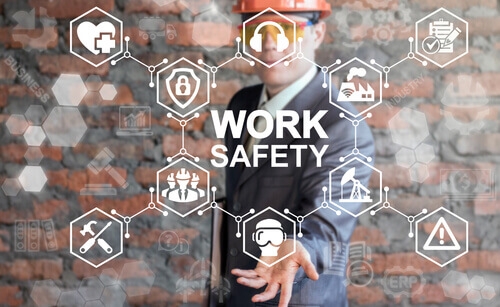The Management of Health and Safety at Work Regulations 1999 which came into force on the 29th December 1999 (also called the Management Regs or MHSWR) is an important piece of UK Health and Safety law. Whereas the Health and Safety at Work etc Act 1974 outlines the general duties of employers, self-employed people and employees, the Management of Health and Safety at Work Regulations 1999 is more specific about what these groups of people need to do to protect the health and safety of people whilst at work. The Regulations apply to all employers, self-employed people and employees in every industry.
The purpose of this article is to explain the main duties of employers, self-employed people and employees under the Regulations and the potential consequences of breaching them.
Some of the duties contained within the Management Regs also overlap with other specific Regulations, for example, there is some overlap with the Control of Substances Hazardous to Health (COSHH) Regulations. Where overlap occurs between two Regulations, if employers comply with the specific legislation, this will usually be sufficient to also comply with the Management Regs.
The below information is not an exhaustive list of everything covered in the Regulations. This article just discusses some of the main duties detailed in the Management Regulations.
Regulation 3 – Risk Assessments
Regulation 3 of the Management of Health and Safety at Work Regulations 1999 is very important because it covers risk assessments. The Regulations refer to a suitable and sufficient assessment of risks. What does suitable and sufficient mean? According to the HSE a suitable and sufficient risk assessment means that:
- A proper check was made.
- The assessment covers who might be affected.
- It covers all the obvious significant risks, considering the number of people who could be involved.
- The precautions are reasonable, and the remaining risk is low.
- Workers or their representatives were involved in the risk assessment process.
Employers
Regulation 3 places a legal duty of care onto employers to carry out risk assessments to protect the health, safety and welfare of their employees as well as others who can be affected by their work activities such as members of the public, contractors, visitors to their premises or if working on a client’s premises, the client’s employees.
If an employer has 5 or more employees, risk assessments need to be recorded and the employer needs to identify any groups of people especially at risk. Risk assessments need to consider young people (those under 18 years of age) where applicable.
The Regulations put a duty on employers to review a risk assessment if they believe a risk assessment is no longer valid or if there has been a significant change. For example, this could be a change in the way the work is carried out, the introduction of a new piece of machinery, a new hazardous substance being used or change in an employee’s health.
Self-Employed People
Regulation 3 also puts a legal duty of care onto self-employed people to assess the risks to their own health and safety and the health and safety of those who can be affected by their work. Again a risk assessment will need to be reviewed if the self-employed person believes the risk assessment is no longer valid or if there has been a significant change.
Regulation 4 – Principles of Prevention
The Regulations detail the order in which employers should consider when implementing control measures in order of effectiveness. At the top of the list when considering controls, is to avoid the risk altogether, if possible, for example, can the work be completed another way which avoids the hazard? If not, you would work down the Principles of Prevention list.
Regulation 5 – Health and Safety Arrangements
Regulation 5 states that every employer shall make appropriate health and safety arrangements which are suitable in terms of the size of the organisation and the nature of the organisation’s activities for ‘the effective planning, organisation, control, monitoring and review of the preventive and protective measures.’
What does the Regulations mean by health and safety arrangements? This is referring to the organisation’s health and safety policy. A health and safety policy would normally contain the organisation Health and Safety Statement of Intent, a responsibilities section and an arrangements section. If an employer has 5 or more employees, this information needs to be recorded. If an employer has less than 5 employees, they still need to have health and safety arrangements in place, but they do not need to be written down.
Regulation 6 – Health Surveillance
Regulation 6 states that all employers shall ensure that employees are provided with appropriate health surveillance as identified within the risk assessment.
So what is health surveillance? According to the HSE, health surveillance ‘is a system of ongoing health checks. These health checks may be required by law for employees who are exposed to noise or vibration, ionising radiation, solvents, fumes, dusts, biological agents and other substances hazardous to health, or work in compressed air’.
Health surveillance is a good way of checking that the control measures you have implemented are sufficient and working. Also by having a health surveillance programme, signs of ill health can be picked up early so that better control measures can be implemented to avoid long term exposure which could make the ill health worse.
Regulation 7 – Health and Safety Assistance
Employers are legally required to appoint one or more competent people to assist them in fulfilling their health, safety and welfare responsibilities in the workplace. A competent person can be the employer themselves, an employee or an external person such as a Health and Safety Consultant. To be competent the person needs to have the necessary skills, knowledge and experience. It is important to note, even if the employer appointments a competent person, the employer still has the overall legal duty of care for health and safety within the organisation.
Regulation 14 - Employee’s Duties
It is not just employers who have a legal duty of care under the Regulations, employees also have a legal duty of care too. Regulation 14 states that employees must:
- Use all machinery, equipment, substances and safety devices in accordance with the training they have been given by the employer and in compliance with the relevant statutory provisions.
- Inform employers or the workplace safety representative about any serious or immediate health and safety dangers or any shortcomings in the employer’s health and safety arrangements.
Regulation 15 – Temporary Workers
Regulation 15 of the Regulations is concerning the health and safety of temporary workers. It puts a legal duty of care onto employers and self-employed people to provide temporary workers before they start work:
- Information about occupational qualifications and skills needed for the role.
- Information about the health surveillance required to be provided.
- Information about parts of the role which can affect their health and safety.
Regulation 16 – New and Expectant Mothers
Employers need to consider new and expectant mothers when carrying out their general risk assessments. Employers need to control risks to an expectant mother, her unborn baby and to a new mother.
Employers need to risk assess for hazards from any work processes, working conditions, biological or chemical agent. If a significant risk is identified, employers need to do the following:
1 - Adjust the employee’s working conditions or hours to remove the risk.
If that is not possible:
2 – Give the employee suitable alternative work on the same terms and conditions
If that is not possible:
3 – Suspend the employee on paid leave.
Regulation 19 – Young Persons
Regulation 19 covers occupational health and safety of young persons (employees under 18 years of age) and children (a person under compulsory school leaving age). Employees under 18 years old can be vulnerable due to ‘lack of experience, or absence of awareness of existing or potential risks or the fact that young persons have not yet fully matured’.
The Regulations list hazards that employees under 18 years of age should not be exposed to. This includes work beyond their physical or psychological capacity, harmful exposure to agents, harmful exposure to radiation, extreme heat or cold, noise or vibration. However, there are certain circumstances when young persons (but not children) can be exposed to the above hazards, for example, when it is necessary for their training, when they are being supervised by a competent person and when exposure has been reduced to as low as reasonably practicable.
The Regulations place a duty on employers to carry out a risk assessment before a young person starts work and ensure adequate control measures are implemented.
Changes to the Regulations
It is worth noting there have been some changes to the Management Regs since 1999. Regulation 22 (which is concerning civil liability) was replaced by amendments in 2003, again in 2006 and in 2013 was replaced by The Health and Safety at Work etc Act 1974 (Civil Liability) (Exceptions) Regulations 2013.
Regulations 27 and 28 of the Management of Health and Safety at Work Regulations 1999 have been revoked because they make references to other Regulations which have been revoked and have been replaced by more recent Regulations.
Enforcement of the Regulations and the Consequences of Breaching
If an HSE inspector visits your business and if in their opinion the business has made a material breach of health and safety legislation, the HSE will charge a Fee For Intervention (FFI). The current cost of the FFI is £160 per hour. The HSE will charge for their Inspector’s time covering the whole visit and any subsequent visits or office work such as writing letters and e mails.
For serious breaches, the HSE have the powers to prosecute. Many of the HSE press releases regarding prosecutions are employers not managing risks.
Another consequence of breaching health and safety law is that it could have a negative impact on a business’s image. The HSE have an enforcement register on their website and they issue press releases about recent prosecutions. The negative publicity following a prosecution could be very damaging for a business’s reputation and profitability.



